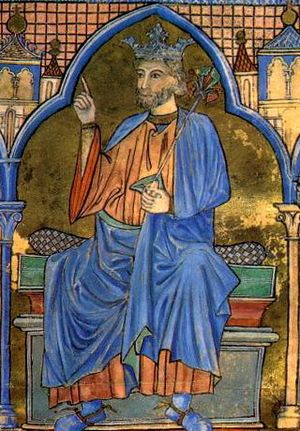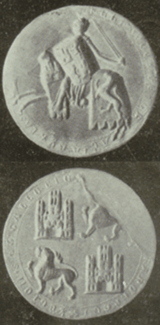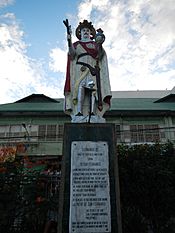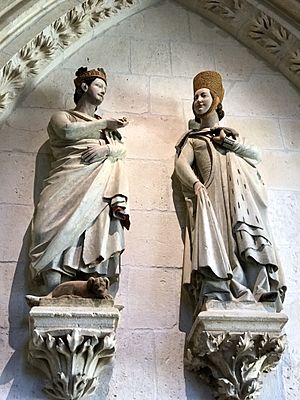Ferdinand III of Castile facts for kids
Quick facts for kids Ferdinand III |
|
|---|---|

Ferdinand III in a 13th-century miniature
|
|
| King of Castile and Toledo | |
| Reign | 31 August 1217 – 30 May 1252 |
| Predecessor | Berengaria |
| Successor | Alfonso X |
| King of León and Galicia | |
| Reign | 24 September 1230 – 30 May 1252 |
| Predecessor | Sancha and Dulce |
| Successor | Alfonso X |
| Born | 1199/1201 Monastery of Valparaíso, Peleas de Arriba, Kingdom of León |
| Died | 30 May 1252 Seville, Crown of Castile |
| Burial | Seville Cathedral, Seville, Spain |
| Consort | |
| Issue among others... |
|
| House | Castilian House of Ivrea |
| Father | Alfonso IX of León |
| Mother | Berengaria of Castile |
| Religion | Roman Catholicism |
Ferdinand III (born between 1199 and 1201, died May 30, 1252) was a very important king in Spanish history. He was known as the Saint (el Santo). He became King of Castile in 1217 and King of León in 1230. He was also King of Galicia from 1231.
Ferdinand was the son of Alfonso IX of León and Berengaria of Castile. He achieved two major things. First, he permanently joined the kingdoms of Castile and León. Second, he led a huge expansion of Christian lands to the south. This was during a time when Islamic rule was weakening in the Iberian Peninsula.
Through his military and diplomatic skills, Ferdinand greatly expanded the lands controlled by Castile. He took over the Guadalquivir river valley in southern Spain. This set the borders for the Castilian state for the next two centuries. Important cities like Baeza, Úbeda, Jaén, Córdoba, and Seville became part of his kingdom. These cities were then given new laws and repopulated.
Ferdinand was made a saint in 1671 by Pope Clement X. Many places are named after him, including cities in the Philippines and the United States. For example, the city of San Fernando, California and the Cathedral of San Fernando in San Antonio, Texas.
Contents
Early Life of Ferdinand III
The exact date of Ferdinand's birth is not fully clear. Some historians think he was born as early as 1199, while others believe it was in the summer of 1201. He was born at the Monastery of Valparaíso, which is in what is now the Province of Zamora.
Ferdinand's parents were Alfonso IX of León and Berengaria of Castile. Both his parents were related to Alfonso VII of León and Castile. His grandfathers, Ferdinand II of León and Sancho III of Castile, were both sons of Alfonso VII.
In 1204, the marriage of Ferdinand's parents was cancelled by Pope Innocent III. This was because they were too closely related. However, the Pope said that their children, including Ferdinand, were still legitimate. After this, Berengaria took her children to the court of her father, King Alfonso VIII of Castile.
In 1217, Berengaria's younger brother, Henry I, died. Berengaria became Queen of Castile, with Ferdinand as her heir. But she quickly gave the throne to her son, Ferdinand.
Ferdinand's father, Alfonso of León, felt tricked. So, the young King Ferdinand had to start his reign by fighting against his own father and some Castilian nobles. But Ferdinand and his mother were very skilled. They proved too strong for the King of León and his allies. Berengaria continued to be a major influence on Ferdinand. He often followed her advice in wars and even when choosing his first wife, Elisabeth of Swabia.
Joining Castile and León
When Ferdinand's father, Alfonso IX, died in 1230, he left his kingdom of León to his older daughters, Sancha and Dulce. They were from his first marriage.
Ferdinand disagreed with this will and claimed the kingdom for himself. Eventually, an agreement was reached. This was mainly thanks to negotiations between his mother, Berengaria, and the daughters' mother, Teresa.
The agreement, called the treaty of Benavente, was signed on December 11, 1230. By this treaty, Ferdinand received the Kingdom of León. In return, his half-sisters, Sancha and Dulce, received a large amount of money and land.
With this, Ferdinand became the first ruler of both Castile and León since Alfonso VII of León and Castile died in 1157. This was a very important step in forming the future country of Spain.
Early in his reign, Ferdinand also had to deal with a rebellion from a powerful noble family, the House of Lara.
Conquering Al-Andalus
After the Battle of Las Navas de Tolosa in 1212, the advance of the Almohads in Spain had stopped. For a while, Castile and the Almohad lands in al-Andalus were mostly at peace.
However, a problem with who would be the next ruler of the Almohad Caliphate started in 1224. This gave Ferdinand III a chance to get involved. One of the Almohad leaders, Abdallah al-Adil, moved most of his army from Spain to Morocco. He wanted to fight for power there. This left al-Andalus almost unprotected.
In 1225, a Castilian army helped al-Bayyasi, a cousin of al-Adil. They campaigned in the regions of Jaén and Granada. By the end of the year, al-Bayyasi was in charge of Córdoba. In return, al-Bayyasi gave Ferdinand important border castles.
Soon after, al-Bayyasi was killed in an uprising in Córdoba. But the Castilians remained in control of the lands al-Bayyasi had given them.
The Almohad Caliphate continued to have problems. In 1228, another Almohad leader, Idris al-Ma'mun, decided to leave Spain. He took the last of the Almohad forces to Morocco. This left al-Andalus broken into many smaller areas, ruled by local leaders.
Seeing this opportunity, the Christian kings of the north began to attack al-Andalus. This included Ferdinand III of Castile, Alfonso IX of León, James I of Aragon, and Sancho II of Portugal. They launched raids almost every year.
There were no big battles. The Andalusian army was defeated early on. So, the Christian armies moved through the south with little resistance. Individual cities had to decide whether to fight or surrender on their own. They had little hope of help from Morocco.
The years from 1228 to 1248 saw the biggest advance in the reconquista (the Christian reconquest of Spain) yet. Many great cities of al-Andalus fell one by one. Ferdinand III gained the most land.
He took Badajoz and Mérida in 1230. Then, by his own efforts, he captured Cazorla in 1231, Úbeda in 1233, and the old capital of Córdoba in 1236. He also took Niebla and Huelva in 1238, Écija and Lucena in 1240.
Later, he gained Orihuela and Murcia in 1243. He captured Arjona, Mula, and Lorca in 1244. Cartagena fell in 1245, and Jaén in 1246. Finally, on December 22, 1248, Ferdinand III entered Seville as a conqueror. Seville was the largest city in al-Andalus.
After these twenty years of conquest, only a small Muslim state, the Emirate of Granada, remained unconquered. Even from Granada, Ferdinand III managed to get a tribute payment in 1238.
Ferdinand added some of his conquered lands directly to the Crown of Castile. Others were first set up as vassal states, ruled by Muslim governors. These included Alicante, Niebla, and Murcia. However, these too were eventually taken over by Castile later in the century.
Ferdinand was careful to negotiate with other Christian kings to avoid conflicts. For example, the treaty of Almizra in 1244 set the border with James I of Aragon in the Murcia region.
Ferdinand divided the conquered lands among his knights, the Church, and the nobility. He gave them large estates called latifundia. When he took Córdoba, he ordered that its citizens follow the Liber Iudiciorum, a set of old laws. He also had these laws translated into an early version of Castilian.
The capture of Córdoba was a well-planned effort. Parts of the city first fell to independent fighters from the mountains. In 1236, Ferdinand arrived with his royal army to take the main part of the city. He then set up a council to divide the conquered lands. Between 1237 and 1244, much land was given to individuals, royal family members, and the Church.
Domestic Policies
At home, Ferdinand worked to make his kingdom stronger. He supported the University of Salamanca and built the famous Cathedral of Burgos.
He was also a big supporter of new religious groups in the Church, called the mendicant Orders. These were orders of friars who lived simply and often begged for food. While older orders like the Benedictines had been important in the Reconquista, Ferdinand founded houses for the Dominican, Franciscan, Trinitarian, and Mercedarian Orders throughout Andalusia. This shaped the religious character of the region for the future.
Ferdinand is also remembered for helping to keep a peaceful coexistence (convivencia) between different religious groups in Andalusia. He himself joined the Third Order of St. Francis, a group for lay people who follow Franciscan ideals.
He was careful not to make his people pay too many taxes. He once said he feared "the curse of one poor woman more than a whole army of Saracens." This shows he cared about his subjects.
Death and Legacy
Ferdinand III started his reign as a king whose claim to the throne was challenged. But by the time he died in 1252, he had given his son and heir, Alfonso X, a much larger and stronger kingdom. The borders of the new Castilian state that Ferdinand III created stayed almost the same until the late 1400s.
His biographer said that on his deathbed, Ferdinand told his son, "you will be rich in land and in many good vassals, more than any other king in Christendom."
Ferdinand was buried in the Seville Cathedral by his son, Alfonso X. His tomb has writings in four languages: Arabic, Hebrew, Latin, and an early form of Castilian.
He was made a saint, St. Ferdinand, by Pope Clement X in 1671. Today, his body is still preserved and can be seen in the Seville Cathedral. He rests in a gold and crystal casket, wearing his golden crown. Many places named San Fernando were founded across the Spanish Empire in his honor.
His royal sword was called Lobera, and it was a symbol of his power.
Patronage
Saint Ferdinand is the patron saint of Seville, Aranjuez, San Fernando de Henares, Maspalomas, and Pivijay. He is also the patron of the Spanish Army's Corps of Engineers, and engineers in general.
Since 1819, Saint Ferdinand has also been a co-patron of the Roman Catholic Diocese of San Cristóbal de La Laguna (in the Canary Islands). This is because La Laguna is connected to the Archdiocese of Seville, which also has Saint Ferdinand as a co-patron. He is also the patron of the University of La Laguna, which was once called the Literary University of Saint Ferdinand.
Family Life
First Marriage
In 1219, Ferdinand married Elisabeth of Swabia (1203–1235). She was the daughter of Philip, Duke of Swabia. They had many children:
- Alfonso X (1221–1284), who became king after him.
- Frederick (1223–1277).
- Ferdinand (1225–between 1243 and 1248).
- Eleanor (born 1227), who died young.
- Berengaria (1228–1288/89), who became a nun.
- Henry (1230–1303).
- Philip (1231–1274). He was supposed to join the Church. But he fell in love with Christina of Norway, who was meant to marry one of his brothers. He left his religious vows and married her. She died in 1262 without children.
- Sancho, who became Archbishop of Toledo and Seville (1233–1261).
- Manuel of Castile (1234–1283).
- Maria, who died as a baby in November 1235.
Second Marriage
After his first wife died, Ferdinand married Joan, Countess of Ponthieu before August 1237. They had five children:
- Ferdinand (1238–between 1264 and 1269), who became Count of Aumale.
- Eleanor (around 1241–1290), who married Edward I of England.
- Louis (1243–1269).
- Simon (1244), who died young and was buried in Toledo.
- John (1245), who died young and was buried in Córdoba.
See also
 In Spanish: Fernando III de Castilla para niños
In Spanish: Fernando III de Castilla para niños




